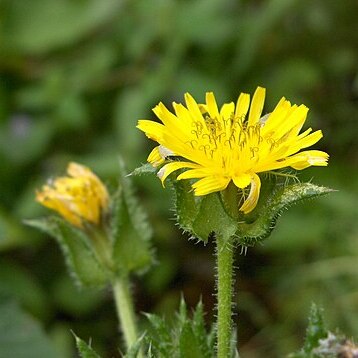Annual to perennial taprooted herbs. Hairs eglandular, stiff, bristly, with 2-4 recurved barbs at apex; lf hairs sometimes with white bulbous bases; spines sometimes present. Stem usually solitary, branched above. Lvs basal and cauline, shallowly dentate to pinnatisect. Capitula terminal and axillary, pedunculate. Involucral bracts in several series, hairy to bristly, the outer either broad and leaflike or similar to the inner. Receptacle areolate, the areoles ciliolate; scales 0. Corolla ligulate, yellow, sometimes red-striped. Style branches filiform, dark. Achenes brown or pale, numerous, terete, transversely wrinkled, beaked or not; pappus white to sordid, in 2 rows, the inner plumose, the outer plumose or simple, sometimes pappus seemingly in 1 row.
Fls all ligulate and perfect, yellow; invol campanulate or ovoid-urceolate, the inner bracts uniseriate, subequal, after anthesis becoming thickened and often clasping the achenes; outer bracts narrow and successively shorter, or sometimes uniseriate, broad and foliaceous; achenes subterete, angled, or somewhat compressed, often incurved, commonly 5–10-ribbed (sometimes obscurely so), tending to be transversely rugulose; pappus of plumose bristles, commonly with some outer, shorter, merely barbellate members, the outer achenes sometimes with the pappus reduced or obsolete; lactiferous herbs with alternate or all basal, entire to pinnatifid lvs. 40, temp. Eurasia, n. Afr.
Capitula many-fld, homogamous; florets ligulate, yellow. Phyll. in several series, outer spreading, inner subequal, erect. Receptacle flat, nude. Anthers acutely sagittate at base. Achenes with 5-10 longitudinal ribs, transversely rugose above, abruptly narrowed to short or long beak. Pappus-hairs in 2 series; outer slender, spreading; inner sparsely plumose, somewhat widened at base. Annual to perennial herbs with white latex; stems and lvs us. coarsely bristly. Genus of c. 40 spp., mainly of temperate regions. The N.Z. sp. has a wide range in temperate regions.

